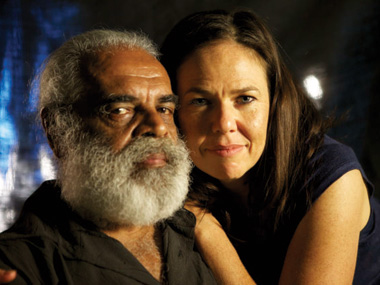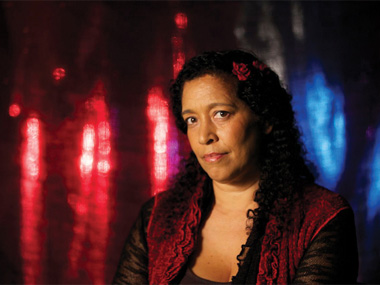THEATRE AS POLITICS

Director of 'The Redfern Story', Darlene Johnson with actor and Superboong, Bindi Williams today
Posted by Jeremy Eccles | 12.06.14
With the shining exception of Stephen Sewell, political theatre in Australia has only ever played the role it might have done – think early David Hare in Britain, Arthur Miller in the US or Eastern European theatre under the yoke of Communism – during the early 1970s. Then, Nimrod Theatre in Sydney converted a stable into a den of ironic political commentary and the Australian Performing Group in Melbourne's Carlton took its politics so seriously that endless divisions caused more splits than a banana, drove David Williamson to Sydney, created the imperishable Circus Oz and encouraged Black theatre into being.
That took the form of the late, great Bob Maza's and the indestructible Jack Charles's Nindethana Theatre. Weirdly, and unexplained by the documentary film which premiered at this year's Sydney Film Festival, Maza quickly moved to Sydney and brought all of his charm and wit (and mellifluous piano playing) with him to magic into being the Black Theatre of Redfern with the Bostock brothers – Lester and Gerry. And for five roistering years, they challenged stereotypes and political correctness with creations like Superboong, Here Comes the Nigger and The Cakeman – cracking television, transferring to the Nimrod and even touring to the US.
Sadly, as Darlene Johnson's affectionate documentary, The Redfern Story refers to en passant, it then suited the official cultural apparatus to tell Black stories through white eyes, with white directors and playwrights rather than encourage further development of an all-Black experience. That may have marginalised someone like Brian Syron – a great, American Studio-trained director and actor – so that his later contribution to Aussie theatre was mainly as a teacher. But Johnson seems to be saying that the 1972 to 77 era was significant enough. Perhaps her real interest lies in the politics rather than the drama.
For what emerges is the catalytic role that Black Theatre had in the mutation of Black Panther-style street politics by activists like Gary Foley and Marcia Langton. And we observe that beautifully in the transformation of the baleful face of Langton – so familiar from The First Australians TV series – to her coming to the edge of tears at the thought that her daughter might be brought up in such a threatening world where “It was a crime to be Black”, with the Redfern police cells “covered in Aboriginal blood” so that they became known as 'The Ab-atoirs'. The future academic leader may have had only very small roles then, but there's a glee in her memories that “It was all tremendously exciting!”. For, as Foley puts it, “We soon realised that theatre was so much more effective than street demotics” at getting their message directly to a largely white audience.
Arguably, that sense of theatre pervaded the next big move by Aboriginal activists – the establishment of the Tent Embassy in Canberra. It also encouraged the group that had set itself up to monitor police activity at demonstrations – The Pig Patrol – to become the pioneering Redfern Aboriginal Legal Service. And that lead on to the Medical Service and Housing. But the nexus between these proactive Indigenous bodies and the theatre continued as they, in turn, gathered in the Redfern theatre's building to feed back their experiences on the street into the next generation of plays.
It's also obvious from the play and TV clips included in the film that the anger of the demos was brilliantly mutated on stage into a wit that was devastatingly effective in getting the message across. “Welcome to Colour Television” is a brilliant opening to the ABC's first all Black show – which, of course, was presented only in black and white in those days. And Bindi Williams's iconic Superboong – a chubby bespectacled super-hero flying through the city on an obvious wire - must have taken the sting out of that derogative at many a water-cooler conversation. The playing of all white roles by Black actors with a white half mask also had the effect of diminishing the racial stereotyping that could have put viewers' backs up.
Redfern itself becomes part of the film's conversation. Country-boy, Gary Foley recalls its post-War importance as the place where any “landless refugee” could find a bed and support. Though he also reveals, to my surprise, that it didn't really exist as a uniquely Indigenous community until the 1960s, leaping in population from 2 to 20,000 in a very short time as Aboriginal identity became more and more acceptable in the lead-up to the '67 Referendum. Not that this crowding didn't influence police thinking. It turns out that getting your pay at the end of the week at the Black Theatre depended a lot on how much money had disappeared from the bail fund that week to permit the more activist actors to actually appear on stage.
Away from the politics, The Redfern Story delights in offering glimpses of the young Justine Saunders – no longer with us – and Lillian Crombie, who is, but in more generous form than her 1970s persona as a hopeful dancer. What a spunk young Gary Foley was; and what a beauty the winsome Marcia Langton. And what a drama there was in getting Bobby Merritt out of prison to attend the premier of his play, The Cake Man. But let's not forget that there were white participants in this great development – Bryan Brown and Max Cullen both reveal a clear understanding of their walk-on roles in this Black story.
Pity Bob Maza wasn't around too to recall his part and make the point that he did so strongly in The Companion to Theatre in Australia in 1995. “In the main, white writers are preoccupied with justifying their existence in this land....still standing on the outside, peeping through the fence. Black writers on the other hand, do not have (centuries of) European theatre to clone from, so standards and procedures do not inhibit free flight; Black theatre is exploring new heights”.
The Redfern Story was made for the ABC, so presumably will appear on television in time.
And, while we're on the important subject of history, news from Sydney's Carriageworks art centre:
In 1938, while Australia celebrated its sesquicentenary, Aboriginal leaders and activists rallied from across the Country to an all-Aboriginal Conference held in Australia Hall in Elizabeth Street, Sydney to declare a National Day of Mourning. For Hereby Make Protest, which opens 17 June, Carriageworks has commissioned artists Karla Dickens, Nicole Foreshew and Jacob Nash to create new works evoking the fighting spirit of these Aboriginal political activists. This exhibition brings together artworks, important archives and found objects to tell the story of an important time in Australian history.
Artist Floor Talk - Sat 12 Jul, 1pm
Join artists Nicole Foreshew and Jacob Nash on a guided tour of the Hereby Make Protest exhibition.
Share this:
»  del.icio.us
»
del.icio.us
»  Digg it
»
Digg it
»  reddit
»
reddit
»  Google
»
Google
»  StumbleUpon
»
StumbleUpon
»  Technorati
»
Technorati
»  Facebook
Facebook
Contact Details

Rachel Maza - daughter of the Black Theatre's founder, Bob - recalls epsiodes from the 70s in the documentary, 'The Redfern Story'.
Further Research
News Tags: Aboriginal theatre | Black Theatre | Bob Maza | Gary Foley | Jeremy Eccles | Redfern Story | Sydney Film Festival
Exhibition Archive
- 10.10.17 | TARNANTHI 2017
- 11.08.17 | Natsiaas 2017
- 20.07.17 | APY ART DOMINATES THE WYNNE
- 17.07.17 | Anangu Artist Wins $100,000 Prize
- 14.07.17 | The End of AAMU
- 11.07.17 | ART ACROSS THE COUNTRY
- 11.07.17 | TARNANTHI IN OCTOBER
- 05.07.17 | TJUNGUṈUTJA - from having come together
- 13.06.17 | Ghost-Nets Straddle the World
- 07.06.17 | Grayson Perry Going Indigenous?
- 05.06.17 | Barks Bigger than Ben Hur
- 27.05.17 | NGA QUINQUENNIAL 2017
- 21.05.17 | Blak Douglas Finds Home at the NGA
- 21.05.17 | BRIAN ROBINSON WINS HAZELHURST WOP
- 18.05.17 | PARRTJIMA 2.0
Advertising

